
The Thomisidae are a family of spiders, including about 175 genera and over 2,100 species. The common name crab spider is often linked to species in this family, but is also applied loosely to many other families of spiders. Many members of this family are also known as flower spiders or flower crab spiders.
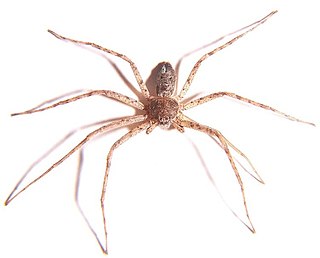
Philodromidae, also known as philodromid crab spiders and running crab spiders, is a family of araneomorph spiders first described by Tord Tamerlan Teodor Thorell in 1870. It contains over 600 species in thirty genera. Most are dull colored- brown, gray, yellowish or mottled with a leaf-like cardiac mark on the anterior dorsal abdomen, and seldom reach above 10 millimetres (0.39 in) long. None of the species build webs, but they do use silk for draglines and egg sacs.
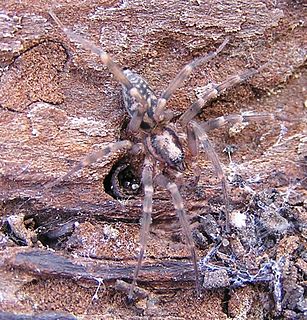
Liocranidae is a family of araneomorph spiders first described by Eugène Simon in 1897. They are one of several groups called "sac spiders". The holarctic genus Agroeca is the best-known, but it also includes various genera of more obscure spiders that still lack a diagnosis. Two species in the North American genus Neoanagraphis are found in the extremely dry conditions in the Mojave, Sonoran and Chihuahuan deserts. Females live in animal burrows while males wander and are the ones most often caught in pitfall traps.

Tord Tamerlan Teodor Thorell was a Swedish arachnologist.

The spider genus Steatoda, in the family Theridiidae, includes about 120 recognized species, distributed around the world. One common name is cupboard spider, for many species build their webs in dark, sheltered, undisturbed places around the house or garden, in sheds and garages, under garden furniture, compost bins, and the like. Signs of the cupboard spider include small white spots of spider droppings, like small splashes of paint, on the floor underneath the web.

Steatoda nobilis is a spider in the genus Steatoda, known in the United Kingdom as the noble false widow and is often referred to as the false widow. As the common name indicates, the spider superficially resembles and is frequently confused for the black widow and other spiders in the genus Latrodectus. S. nobilis has medically significant venom, where in England, it has a reputation as one of the few local spider species that is capable of inflicting a painful bite to humans, with most bites resulting in symptoms similar to a bee or wasp sting.

Cheiracanthium, commonly called yellow sac spiders, is a genus of araneomorph spiders in the family Cheiracanthiidae, and was first described by Carl Ludwig Koch in 1839. They are usually pale in colour, and have an abdomen that can range from yellow to beige. Both sexes range in size from 5 to 10 millimetres. They are unique among common house spiders because their tarsi do not point either outward, like members of Tegenaria, or inward, like members of Araneus), making them easier to identify. The name is a reference to the backwardly directed process on the cymbium of the male palp. The species epithet is derived from the Greek Ancient Greek: χείρ, romanized: cheir, meaning "hand", and Acanthium, a genus of thorny-stemmed plants.
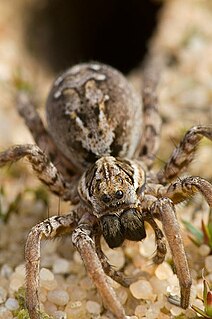
Alopecosa is a spider genus in the family Lycosidae, with about 150 species and several subspecies.

The book Svenska Spindlar or Aranei Svecici was one of the major works of the Swedish arachnologist and entomologist Carl Alexander Clerck and appeared in Stockholm in the year 1757. It was the first comprehensive book on the spiders of Sweden and one of the first regional monographs of a group of animals worldwide. The full title of the work was Svenska Spindlar uti sina hufvud-slägter indelte samt under några och sextio särskildte arter beskrefne och med illuminerade figurer uplyste – Aranei Svecici, descriptionibus et figuris æneis illustrati, ad genera subalterna redacti, speciebus ultra LX determinati, and included 162 pages of text and 6 colour plates. It was published in Swedish, with a Latin translation printed in a slightly smaller font below the Swedish text.
Cheiracanthium elegans is a species of spider in the genus Cheiracanthium found in Europe and Central Asia.

Alopecosa striatipes is a wolf spider species in the genus Alopecosa found in Europe and Central Asia.
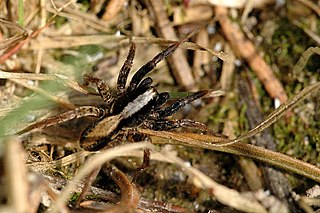
Alopecosa is a species of wolf spiders in the genus Alopecosa with a palearctic distribution.
Dasumia is a genus of woodlouse hunting spiders that was first described by Tamerlan Thorell in 1875.
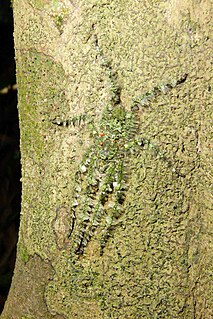
Pandercetes is a genus of huntsman spiders that was first described by Ludwig Carl Christian Koch in his 1875 treatise on Australian spiders. They are mainly distributed in tropical Asia and Australia, and are known for their cryptic coloration that matches local moss and lichen. Their legs have lateral hairs, giving them a feathery appearance, further masking their outline against tree trunks. Their head is somewhat elevated and the carapace has the thoracic region low and flat.

Hemicloea is a genus of South Pacific flat spiders that was first described by Tamerlan Thorell in 1870. Originally placed with the ground spiders, it was moved to the Trochanteriidae in 2018.
Mansuphantes is a genus of dwarf spiders that was first described by Michael I. Saaristo & A. V. Tanasevitch in 1996.
Minicia is a genus of dwarf spiders that was first described by Tamerlan Thorell in 1875.
Sagana rutilans is a species of spiders in the family Liocranidae. It was first described in 1875 by Thorell. As of 2020, it was the only species in the genus Sagana. It is found from Europe to Georgia. The genus name SaganaThorell, 1875 is a junior homonym of the moth genus SaganaWalker, 1855, so the combination Sagana rutilans is unavailable, but as of October 2020 was still used in the World Spider Catalog.












